Australian Bull Ray
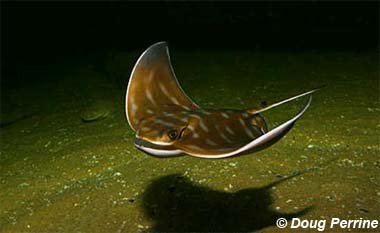
Myliobatis australis
This rather small and incredibly shy ray was made famous over the accidental death of celebrity Steve Irwin. They only grow to almost 4 feet wide and are quick to retreat when humans approach, but they have long venomous stinging spines at the base of their whip-like tails. Their angular pectoral disks tend to be dark olive to brown-gray on top, with light bars and spots, and pale underneath.
They prefer sandy flats and seagrass beds, but come up into shallow waters after crabs and shellfish in the evenings.
Order – Rajiformes
Family – Myliobatidae
Genus – Myliobatis
Species – australis
Common Names
English language common names include Australian bull ray, bull-ray, cowfish, eagle ray, mill ray, southern eagle ray, whip ray, and whiptail ray. Other common names are Australische adelaarsrog (Dutch), Australischer adlerrochen (German), Australsk ørnerokke (Danish), and siba australská (Czech).
Importance to Humans
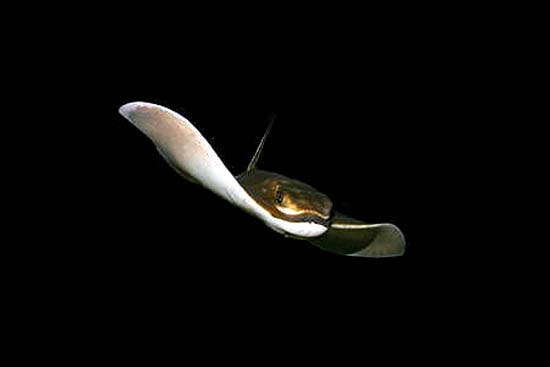
This ray is not targeted by directed commercial fisheries, however it is often taken as bycatch by demersal gillnets, setlines, longlines, beach seine fishers, and demersal prawn and scallop trawlers. It is often kept and marketed for human consumption as catches of other targeted species diminish. It is sold as “skate wings”, “ray flaps”, or “eagle ray flaps”. It is considered a game fish by recreation fishers, providing a powerful fight when caught on a line. Scuba divers find it difficult to approach the Australian bull ray in most areas of its distribution as it is quite shy and avoids interaction.
Danger to Humans
The Australian bull ray is considered venomous due to its stinging spine located on the tail. As with other rays possessing such a spine, care must be taken when handling or in the vicinity of this species. A high profile incident involving this species was the death of media celebrity Steve Irwin who was killed by an Australian bull ray in a freak accident when he was pierced in the chest by its venomous spine.
Conservation
Populations of the Australian bull ray may be declining as suggested by catch per unit effort data on trawlers fishing waters off New South Wales. However, this is only on the fringe of the distribution range for this species otherwise data is deficient to make any accurate assessment.
Potential threats to this ray include increased landings as rays are becoming more popular in seafood markets. Also the increased use and development of shallow water embankments within its distribution range off southern Australia may impact the Australian bull ray population.
Currently there are no management or conservation measures in place specifically for this species although marketed catches should be monitored to determine if the harvest is sustainable. The “Australian National Plan of Action for the Conservation and Management of Sharks” will assist in the conservation and management of all sharks and related species, including rays, in Australian waters.
> Check the status of the Australian Bull Ray at the IUCN website.
The IUCN is a global union of states, governmental agencies, and non-governmental organizations in a partnership that assesses the conservation status of species. The balloonfish is listed as Least Concern. The “Least Concern” listing is given when the species does not qualify for Critically Endangered, Endangered, Vulnerable or Near Threatened.
Geographical Distribution
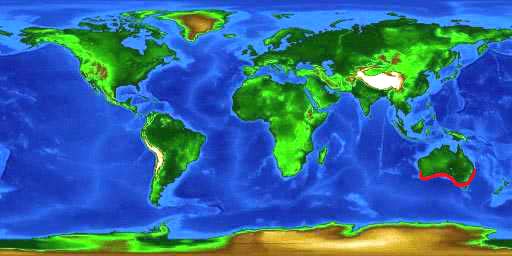
The Australian bull ray is limited to the waters off southern Australia, from Western Australia to Queensland. This ray also possibly occurs off New Zealand. It is uncommon at the northern limits of its distribution range.
Habitat
Often observed off beaches and over sandy flats and seagrass beds in shallow waters of the intercontinental shelf, the Australian bull ray is also found offshore in waters to 280 feet (85 m) in depth. They move into shallow waters to feed on crabs and shellfish at dusk.
Biology
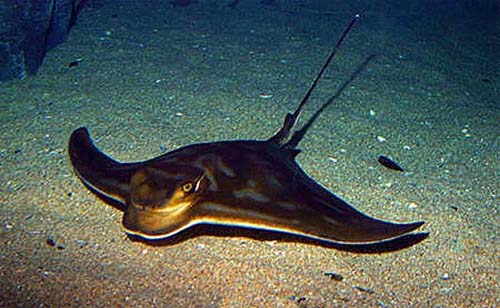
Distinctive Features
The Australian bull ray has a disc that is wider than it is long. The snout is blunt with a skirt-shaped internasal flap as well as a single fleshy lobe that surrounds the snout and almost reaches the pectoral fins. The medium-sized eyes are located on the sides of the head and the spiracles are large.
The pectoral fins which make up the “wings” of this ray originate below the eyes. The margins of the pectoral fins are deeply concave and the tips are highly angular. There is a small dorsal fin that originates over or just behind the pelvic fin rear tips and is anterior to the spine on the tail. The tail is elongate and whip-like and has a venomous stinging spine located just behind the dorsal fin.
Coloration
The dorsal surface of the Australian bull ray is brownish gray to olive green or yellowish with bluish spots and crescent-shaped bars. This ray is a paler color on the ventral surface sometimes with a grayish margin on the disc.
Dentition
The teeth of the Australian bull ray are plate-like, with 7 rows in each jaw although the outer rows can sometimes be hidden or small. The teeth located in the central row are very broad with each of these teeth measuring more than five times the width of adjacent teeth.
Denticles
The surface of the skin is smooth, lacking thorns and denticles.
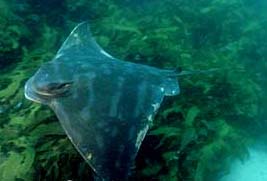
Size, Age, and Growth
The maximum reported disc width of the Australian bull ray is 3.9 feet (1.2 m). The maximum reported weight of this ray is 124.6 pounds (56.5 kg). Males reach maturity at a disc width of approximately 2.1 feet (.65 m), with females becoming mature at a disc width of about 2.6 feet (.80 m).
Food Habits
The Australian bull ray feeds primarily on crabs including hermit and swimmer crabs as well as molluscs, echiurid worms and polychaetes.
Reproduction
This ray exhibits ovoviviparous reproduction with embryos initially feeding on yolk, followed by additional nourishment from the mother through the indirect absorption of enriched uterine fluid via specialized structures. Australian bull rays move into shallow bays and inlets during the spring and summer months for mating and/or to give birth. Each female gives birth to litters of 2-15 (average 6) young, each of which measures approximately 7.9-11.8 inches (20-30 cm) disc width. Although reproductive periodicity is unknown, it is thought to be anywhere from one to three years in length.
Predators
Potential predators of the Australian bull ray include larger fish such as sharks as well as marine mammals.
Parasites
A mongenean, Heliocotyl ewingi sp. n. has been reported on the gills of the Australian bull ray. Another monogenean, Dendromonocotyle bradsmithi n. sp. has been documented on the skin of this ray.
Taxonomy
Macleay originally described the Australian bull ray as Myliobatis australis in 1881. The genus name, Myliobatis, is derived from the Greek ‘mylo’ meaning mill and ‘batis, -idos’ translated as a ray. There are no known synonyms referring to this species in past scientific literature.
The New Zealand eagle ray, M. tenuicaudatus (Hector 1877), may actually be conspecific with the Australian bull ray. If they are indeed the same species, then the scientific name M. tenuicaudatus has precedence. However, at this time the geographic separation of these two subpopulations warrants separate species assignments until this issue is resolved.
Prepared by: Cathleen Bester